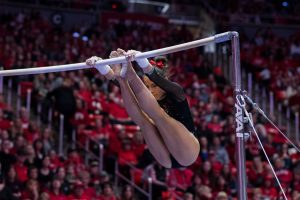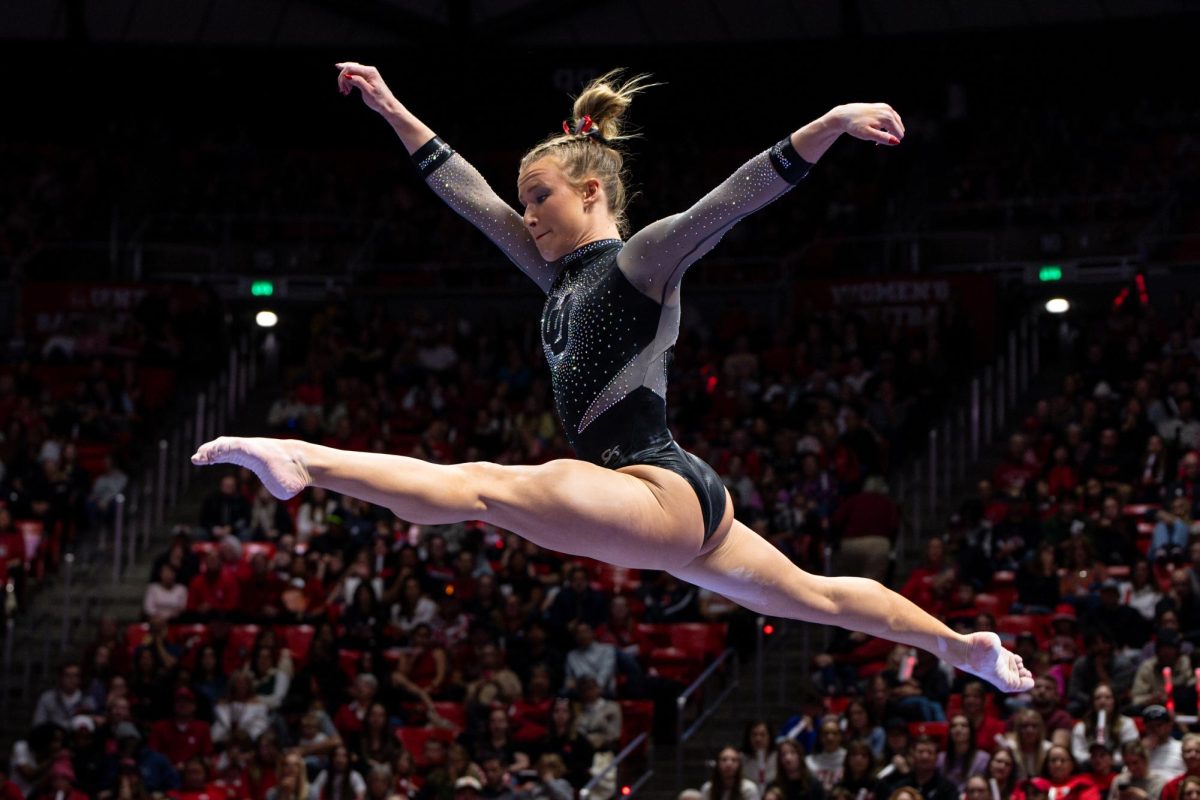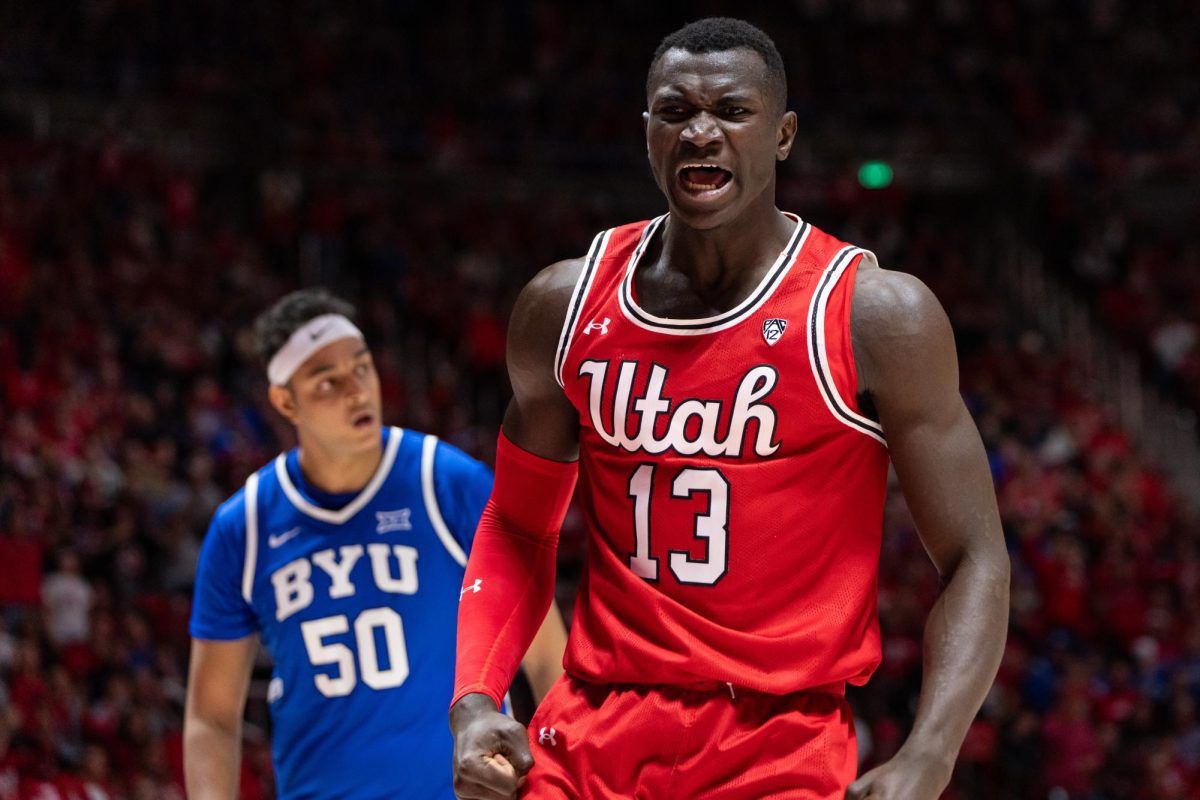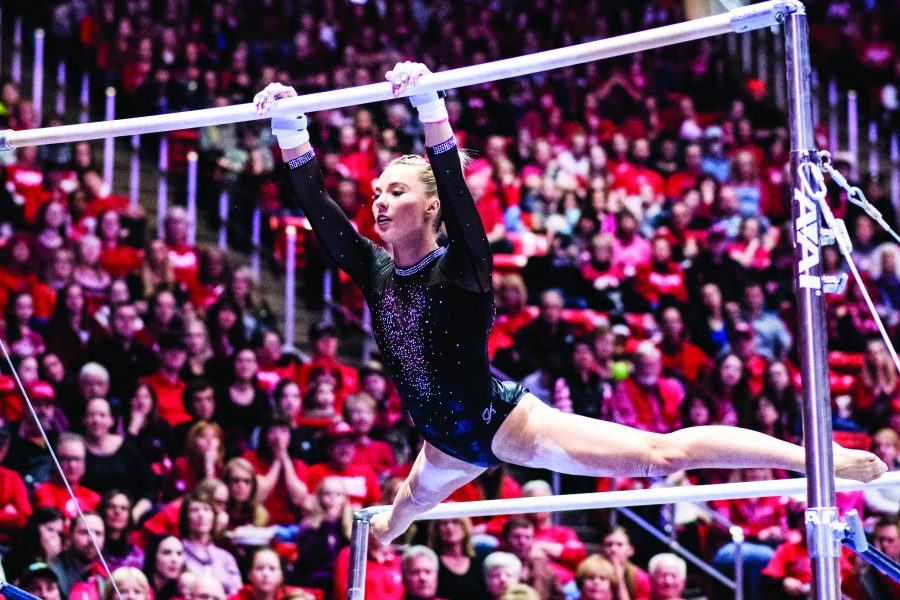The uneven bars are the first event that has a predetermined set of skills that an athlete has to compete with in order to have a complete routine.
The uneven bars are also the only event that does not rely on tumbling — all of the skills are done with one’s arms. University of Utah co-head and bars coach Tom Farden said that having the event depend on arm and upper body strength makes it so unique.
“Bars is the only event that doesn’t replicate the other events. It’s on your hands, all the other ones replicate tumbling and they are all spawned from a tumbling element,” Farden said.
While the requirements might be somewhat straight forward, deductions on this event are harder to figure out, with there being so many variables in the event. Let’s talk about what an athlete needs in a bar routine.

(Photo by Curtis Lin | The Daily Utah Chronicle)
What’s in a bar routine?
The most basic routine a gymnast can do on this event consists of threeA-level skills, three B-level skills and two C-level skills. That is the across-the-board requirement for most events other than the vault.
Routines must also include two transitions, meaning the gymnasts must go from either the low bar to the high bar and back to the low, or from the high bar to the low bar and back. The gymnast must also have two flight elements, not including their dismount. This could be something like a release from the top bar or a flight piece from one bar to the other.
The gymnast must also have a turning element that is at least a C-level skill. This doesn’t mean they have to do a full turn on the bar. It could be something like a bail handstand where they turn during the transition from high to low bar. The only requirement for this element is that the gymnast does at least a half turn at some point.
The final requirement is the dismount, which must be at least a C-level skill. The main problem with dismounting with this skill level is some gymnasts need to wind up taking on the dismount. Doing a windup before this dismount leads to a 0.1 point deduction. Most gymnasts tend to dismount with a D-level skill to avoid the deduction coming from that.
If an athlete misses any part of this routine, they lose 0.2 off of their start value. Any routine that just has the basic skill levels of A, B and C has a start value of 9.50 and must add bonus items to push their score to a 10.0.
Each D-level skill that a gymnast adds gives them an extra 0.1 towards their score. An E-level skill gives an extra 0.2. They can also earn extra points from connection value for their routine.
Deductions:
Just like in the vault, deductions on this event can be somewhat sketchy. There are some straightforward mistakes like falls, but there are things that are harder to see in some cases for judges, like separated legs and handstands that are not perfectly vertical.
The biggest place that deductions can come from is if the gymnast falls off the apparatus. If they fall off one of the bars, it is an automatic 0.50 deduction on their routine. There usually isn’t that much room for leeway with this, no matter the severity of the fall.
The landings are another place where deductions can come from. Unlike obvious falls, this category is more ambiguous. Small steps are usually only deducted 0.05 while larger steps are 0.10. To a certain extent this can be subjective. To one judge, a step could be considered large, but to another it could be small.
Going along with steps is hops. In most cases, hops get a bigger deduction than steps because steps show that the gymnast has more control if they can make sure one of their feet plants rather than either of their feet staying in one spot. Small hops tend to only be deducted 0.05 of a point, whereas bigger hops are usually more than that.
There is a phenomenon in NCAA gymnastics called the “college stick,” where a gymnast hasn’t actually stuck the landing, but they try to cover up the fact that they didn’t have full control by using the step they took to slide into their salute to show that they had full control. Usually, a “college stick” only results a 0.05 point deduction, even if the step was large enough to have received a 0.1 deduction.

(Photo by Curtis Lin | Daily Utah Chronicle)
Gymnasts can also be deducted on their landing for mistakes like coming up short, landing with their legs locked or jarring their body on their landing.
Landing deductions can go as high as 0.30 off of the total score, but that only happens on multi-step landings.
A judge’s job can be hard when it comes to deductions about handstands. According to the NCAA rulebook, handstands are expected to be within 10 degrees of vertical in order to not receive deductions. But how is a judge going to know if someone is at nine degrees versus 11? This is something that, again, is subjective for the judges. The judges also look for bent elbows on handstands.
For senior gymnast Kari Lee, the handstands are everything.
“If everyone is hitting their handstands at vertical, and you see someone who is a little shorter [than vertical], judges are going to give deductions to the not-vertical one, even though it says within ten degrees,” Lee said.
Other deductions can come from flexed feet during the routine, lack of amplitude during the flight sequences and leg separation.
Leg separation is one that is hard to determine as most judges are not at the right angle to fully see if a gymnast’s legs are separated or not when they land on their dismount.
What makes the event so enjoyable?
To Farden, the skill level element makes it so the fans get more into the event and are entertained.
“The higher the skill level, the more wow factor there is. I’ve always equated gymnastics to a spectator sport because it is death-defying,” Farden said. “On bars, the more spins and flips and higher value the skill is rated, it attracts the eye.”
Lee sees the event as one where she has had to learn to slow down when it is her turn because there is no time limit that she has to meet.
“Robert [Ladanyi] made a really good point, bars is not timed, so you can take your time on that event and sometimes I get ahead of myself so I just kinda rush the skills, so I’ve taken the approach to swing more calmly and relaxed because the more you tense up the more error happens,” Lee said.
Utah is ranked in the top 10 for this event, and the team is ranked seventh in the nation. The top five teams on the event are Oklahoma, Florida, UCLA, Denver and Auburn.
What’s next?
Balance beam is one of the most difficult events in college gymnastics. Gymnasts must do flips and turns on an apparatus that is only four inches wide. Next week we will dive into the ins and outs of the balance beam.


















